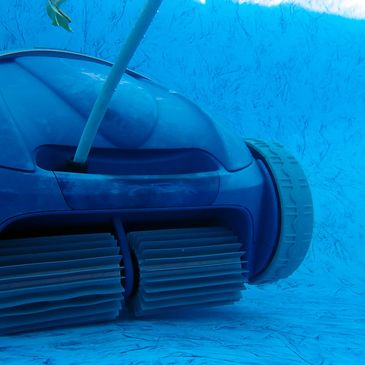The 3 Steps of Pool Cleaning

Skim the Surface & Floor
Brush the Pool Water Surfaces
Brush the Pool Water Surfaces
Step # 1 - Regular cleaning removes leaves, debris, and algae from your pool’s surface and walls. This prevents buildup that can turn the water cloudy or cause algae blooms. Skimming and brushing keep the pool visually appealing and reduce strain on your filter system.

Brush the Pool Water Surfaces
Brush the Pool Water Surfaces
Brush the Pool Water Surfaces
Step # 2 - Brushing the pool walls, steps, and dead spots prevents the buildup of algae, biofilm, and dirt that brushing alone can't remove. These areas often receive less circulation, making them hotspots for algae growth. Regular brushing loosens debris so it can be captured by the filtration system, helping maintain a clean, safe, and visually appealing pool.

Vaccum the Pool
Brush the Pool Water Surfaces
Vaccum the Pool
Step # 3 - Vacuuming the pool removes debris, dirt, and fine particles that brushing and skimming may miss. This can be done manually or with an automatic or robotic pool cleaner. Regular vacuuming helps prevent staining, reduces the load on the filtration system, and keeps the pool floor clean and inviting.
Skim the Surface & Floor
Skim the Surface and Floor
Use two types of skimmers to manually remove debris:
- Flat Leaf Skimmer: For leaves and insects floating on the surface.
- Deep Leaf Rake (basket-style): For heavier debris resting on the pool floor.
Why it matters:
Removing debris manually reduces strain on the filtration system, prevents algae growth, and keeps the pool visually clean.
Pro Tip:
Start with the surface, then move to the floor. Be thorough around corners, steps, and drains where debris can settle.

Brush the Pool Water Surfaces
Brush Pool Walls, Steps, and Dead Spots
The pool requires regular brushing to remove invisible buildup and disrupt early-stage algae growth:
- Wall Brush: Ideal for scrubbing pool walls to remove fine debris and microscopic algae spores.
Why it matters:
Algae and biofilm start off microscopic and invisible—water can look crystal clear even while algae is beginning to grow. It takes billions of spores per ounce before algae becomes visibly green. Brushing breaks up these early colonies before they bloom, helping to maintain water clarity, prevent staining, and reduce chemical demand.
Pro Tip:
Brush the entire pool at least once a week—even areas that look clean. Focus extra attention on shaded spots, corners, and behind ladders where circulation is weakest and algae is most likely to start.

Vacuum the Pool
Vacuum the Pool
Choose one method to remove dirt and debris from the pool floor and walls:
- Manual Vacuum: Connects to the skimmer or vacuum port; best for targeted cleaning and heavier dirt buildup.
- Automatic Vacuum: Robotic or suction-side cleaners that run independently to keep the pool floor clean with minimal effort. Despite manufacturer claims, these cleaners often run in random patterns and may miss steps, corners, or dead spots — especially in irregularly shaped pools.
Why it matters:
Vacuuming removes settled dirt and sediment that cloud the water and promote algae growth. It also reduces the workload on your filtration system and helps maintain proper water clarity.
Pro Tip:
Even if you use a robotic cleaner, spot-check the pool weekly and manually vacuum or brush missed areas to ensure full coverage and consistent water quality.

This website uses cookies.
We use cookies to analyze website traffic and optimize your website experience. By accepting our use of cookies, your data will be aggregated with all other user data.
